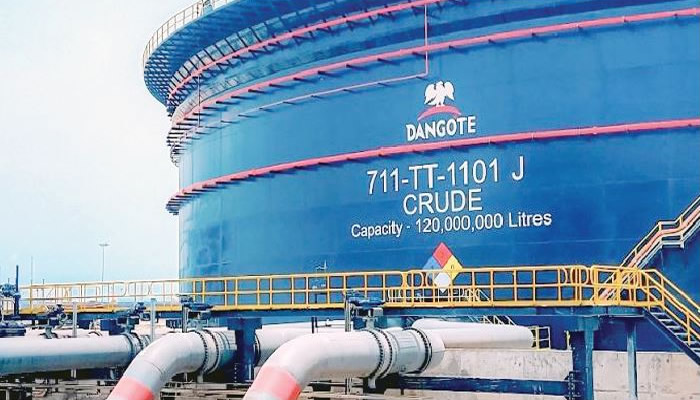Dangote Petroleum Refinery has taken a major step toward transforming Nigeria’s downstream petroleum sector by deploying 1,000 of the 4,000 planned compressed natural gas-powered fuel distribution trucks. The deployment is part of its direct-to-market strategy aimed at supplying fuel to marketers, large industries, telecoms firms, and aviation users. Meanwhile, the Independent Petroleum Marketers Association of Nigeria (IPMAN) has thrown its weight behind the initiative, even as concerns persist over market disruption and job implications for tanker drivers.
The refinery had initially announced that this ambitious roll-out would occur by August 15, 2025. Its plan involves using a fleet of 4,000 CNG-powered trucks to deliver refined products such as Premium Motor Spirit (PMS) and diesel directly to points of sale, bypassing traditional logistics intermediaries. So far, 1,000 trucks have arrived, though the full complement is expected pending further importation and regulatory clearances. The early arrival is being viewed by many in the downstream value chain as a signal that the plan is beginning to take concrete shape.

IPMAN has reacted positively to the development. Its leadership says that the direct distribution model promises significant cost savings, especially on transportation and logistics, which have historically increased fuel prices at the pump. According to IPMAN’s spokesperson, Chinedu Ukadike, the cheaper cost base afforded by CNG-powered trucks will allow marketers to reduce retail rates, improve margins, and thus recover from losses incurred under previous supply and pricing regimes. Ukadike pointed out that marketers are increasingly registering with Dangote for the scheme, with over 25 marketers now onboard, up from only a handful when the plan was first announced.
For many marketers, the attraction lies in avoiding the high cost of lifting fuel from depots, paying haulage and insurance, and dealing with delays or payment uncertainties associated with third-party transport providers. Under Dangote’s scheme, transportation costs are expected to be partly or wholly handled by the refinery, making the distribution chain leaner and potentially more stable.
However, not all stakeholders are completely unreserved in their support. Tanker drivers and independent transport operators have raised alarm, warning of potential displacement as Dangote’s trucks begin serving filling stations directly. Some fear that many drivers who currently transport fuel from depots to retailers could become redundant or lose contracts. There are ongoing discussions with transport associations to find ways to accommodate or absorb impacted operators.
Market traders and retailers are also watching closely. For industrial users, telecom operators, and aviation firms, stable and lower-cost supply from a domestic refinery promises relief, especially given the volatile costs of imported refined products. Companies in logistics-intensive sectors argue that predictable fuel supply can reduce operating expenses, improve turnaround times, and reduce dependency on fluctuating international pricing and shipping delays.
IPMAN has also emphasised that while the plan is welcome, safeguards are needed. The association has asked regulators to ensure that the price benefits from cheaper logistics are passed through to end users. They have called for transparency in pricing agreements, equitable access to trucks, and assurances that no region will be underserved. Marketers also want guarantees that the scheme does not turn into monopolistic control by one refinery dominating supply and logistics at the expense of smaller competitors.
Dangote, for its part, has defended the move as aligned with the deregulated downstream policy, and part of the company’s broader goal to ensure energy security, cost reduction, and more efficient supply chains. The refinery insists that the initiative will lessen dependence on imported refined products, reduce wastages and losses in transportation, and improve overall access to fuel across the country.
Some economists believe that if the distribution scheme works as planned, it could reduce pump prices significantly in many states, particularly in outlying and hard-to-access areas where haulage and transport costs usually push prices up. The use of CNG-powered trucks, which are less expensive to maintain and operate than traditional diesel fuel trucks, could also reduce environmental pollution and running costs in the long term.
Still, challenges remain. The arrival of only 1,000 of the planned 4,000 trucks leaves the execution of the full plan vulnerable to logistical delays, import hurdles, and regulatory bottlenecks. Issues around numbering of trucks, duty, licensing, and route authorisations must be resolved. Also, ensuring that fuel distribution isn’t interrupted by infrastructure deficits—road quality, access to depots, and fuel stations—will be crucial.
In conclusion, Dangote’s deployment of 1,000 trucks and IPMAN’s growing registration of marketers represent a turning point in Nigeria’s downstream fuel landscape. If rolled out smoothly and with proper oversight, the initiative could drive down costs, improve supply reliability, and reshape fuel retailing practices. However, the transition must be managed carefully to avoid unintended consequences like job losses, regional inequalities, or unfair competitive practices. The coming weeks and months will be critical as the scheme shifts from planning into full operation.
Support InfoStride News' Credible Journalism: Only credible journalism can guarantee a fair, accountable and transparent society, including democracy and government. It involves a lot of efforts and money. We need your support. Click here to Donate
